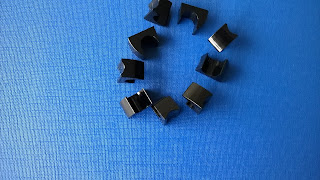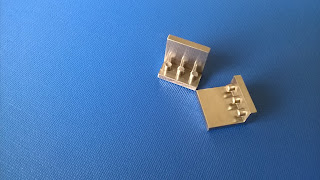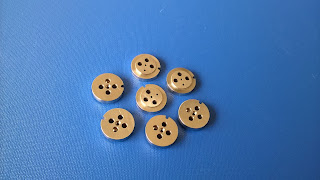Metals
Precision CNC machining parts The use of metals has always been a key factor in the development
of the social systems of man. Of the roughly 100 basic elements of which all
matter is composed, about half are classified as metals. The distinction
between a metal and a nonmetal is not always clear-cut. The most basic
definition centers around the type of bonding existing between the atoms of the
element, and around the characteristics of certain of the electrons associated
with these atoms. In a more practical way, however, a metal can be defined as
an element which has a particular package of properties.
Metals are crystalline when in the solid state and, with few exceptions
(e.g. mercury), are solid at ambient temperatures. They are good conductors of
heat and electricity and are opaque to light. They usually have a comparatively
high density. Many metals are ductile-that is, their shape can be changed
permanently by the application of a force without breaking. The forces required
to cause this deformation and those required to break or fracture a metal are
comparatively high, although, the fracture forces is not nearly as high as
would be expected from simple consideration of the forces required to tear
apart the atoms of the metal.
Precision CNC machining parts One of the more significant
of these characteristics from our point of view is that of crystallinity. A
crystalline solid is one in which the constituent atoms are located in a
regular three-dimensional array as if they were located at the corners of the
squares of a three-dimensional chessboard. The spacing of the atoms in the
array is of the same order as the size of the atoms, the actual spacing being a
characteristic of the particular metal. The directions of the axes of the array
define the orientation of the crystal in space. The metals commonly used in
engineering practice are composed of a large number of such crystals, called
grains. In the most general case, the crystals of the various grains are
randomly oriented in space. The grains are everywhere in intimate contact with
one another and joined together on an atomic scale. The region at which they
join is known as a grain boundary commonly used in engineering practice are
composed of a large number of such crystals, called grains. In the most general
case, the crystals of the various grains are randomly oriented in space. The
grains are everywhere in intimate contact with one another and joined together
on an atomic scale. The region at which they join is known as a grain boundary.
An
absolutely pure metal (i.e. one composed of only one type of atom) has never
been produced. Engineers would not be particularly interested in such a metal
even if it were to be produced, because it would be soft and weak. The metals
used commercially inevitably contain small amounts of one or more foreign elements,
either metallic or nonmetallic. These foreign elements may be detrimental, they
may be beneficial, or they may have no influence at all on a particular
property. If disadvantageous, the foreign elements tend to be known as
impurities. If advantageous, they tend to be known as alloying elements.
Alloying elements are commonly added deliberately in substantial amounts in
engineering materials. The result is known as an alloy.
Precision CNC machining parts The distinction between the descriptors “metal” and “alloy” is not
clear-cut. The term “metal” may be used to encompass both a commercially pure
metal and its alloys. Perhaps it can be said that the more deliberately an
alloying addition has been made and the larger the amount of the addition, the
more likely it is that the product will specifically be called an alloy. In any
event, the chemical composition of a metal or an alloy must be known and
controlled within certain limits if consistent performance is to be achieved in
service. Thus chemical composition has to be taken into account when developing
an understanding of the factors which determine the properties of metals and
their alloys.
Of
the 50 or so metallic elements, only a few are produced and used in large
quantities inengineering practice. The most important by far is iron, on which
are based the ubiquitous steels and cast irons (basically alloys of iron and
carbon). They account for about 98% by weight of all metals produced. Next in
importance for structural uses (that is, for structures that are expected to carry
loads) are aluminum, copper, nickel, and titanium. Aluminum accounts for about
0.8% by weight of all metals produced, and copper about 0.7%, leaving only 0.5%
for all other metals.
As might be expected, the remainders are
all used in rather special applications. For example, nickel alloys are used
principally in corrosion-and heat-resistant applications, while titanium is
used extensively in the aerospace industry because its alloys have good
combinations of high strength and low density. Both nickel and titanium are
used in high-cost, high-quality applications, and, indeed, it is their high
cost that tends to restrict their application.
Precision CNC machining parts We cannot discuss these more esoteric properties here. Suffice it
to say that a whole complex of properties in addition to structural strength is
required of an alloy before it will be accepted into, and survive in,
engineering practice. It may, for example, have to be strong and yet have
reasonable corrosion resistance; it may have to be able to be fabricated by a particular
process such as deep drawing, machining, or welding; it may have to be readily
recyclable; and its cost and availability may be of critical importance.





